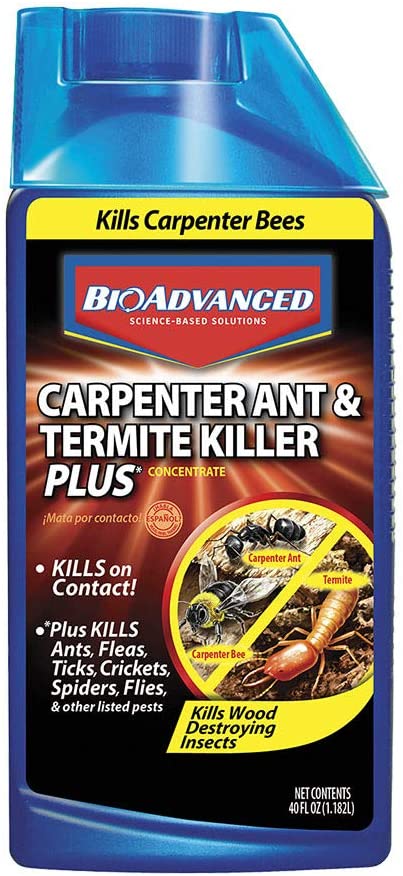Insecticide For Termites And Ants
Termites can weaken or entirely destroy a house’s timber-bearing structures over a few years. Termite extermination is a matter of life and death for your home. A termite treatment that you can do yourself is a must.
So what are the best outdoor deck insecticides to kill flying ants and termites? Harmful pests will have permanently destroyed most wooden buildings when the homeowner finds the existence of termites, and DIY termite remedies will be ineffective. As a result, it’s critical to uncover the insects’ existence as quickly as possible to begin eradicating termites right once.
WHAT SHOULD YOU DO TO CONDUCT AN ADEQUATE DIY TERMITE REMEDY?
- Look for the following indicators of a termite infestation in your home: It doesn’t mean the insects aren’t there just because you didn’t see any traces of them the first time. Sagging floors and minor holes in wooden pieces could be indirect evidence of their presence. These indicators should prompt you to consider eradicating termites immediately. This also goes for any food source of leftovers.
- Gauge the stability of the timber pillars and trusses in the underground with a flashlight and a screwdriver. Make a tapping sound on the wood. If it sounds deep and some grit comes out of it (which is presumably termite dust), termite tunnels have already emptied it out. Another warning indicator is if a screwdriver can readily pierce the wood. It’s the appropriate time to start eradicating termites straight away.
- House termite feces resemble tiny grains that are somewhat darker in color than wood. They can be found under wooden things.
- Find the house termites’ nest: A splitting series of tunnels will lead to the nest, which can be found on the surface from within the timber frames.
- Decide whether it’s subterranean or dry wood. Dry wood termites basically live in wood, while subterranean termites reside underground, inside woodpiles, and manure heaps. Treatments for subterranean termites and dry wood termites differ, so it’s crucial to figure out which species have infected your home.
If termites have infested your home, you must act quickly to avoid more structural damage. Termite killers are available in a variety of forms, including liquid termiticide, baits, and direct chemical treatments.
There is no certainty that a do-it-yourself termite treatment can eliminate termites. The degree of the infestation, the skill of the individual performing the DIY termite treatment, and the termite killer chemicals utilized are all factors to consider.
Since selecting a termite killer might be difficult, we’ve compiled a list of the top termite killers for 2021. While these remedies may provide some temporary respite, they are no comparison for expert termite control.
WHAT’S THE BEST OUTDOOR DECK INSECTICIDE TO KILL FLYING TERMITES?
Termites can harm your home a lot. Fortunately, there are various tools for termite extermination on the market that can assist you in protecting your house. Yet, there are so many alternatives available that picking the finest one might be challenging.
The essential point is that you should choose pesticides with a lot of positive feedback and excellent ratings. You might prefer one of the items listed in this brief review if you want to save time on research. You can rest assured that each of them will give you the most remarkable customer service possible, and you’ll never have to worry about termites again.
COMMERCIAL AEROSOL
Commercial bug poison baits are available for use against all types of ants including carpenter ants, and any ant insecticide spray should be adequate against flying ants. Choose an aerosol kind with an easy-to-direct spout if you want to catch the ants in mid-flight.
- To avoid unintentional and even dangerous abuse, always follow the label directions.
- Don’t use aerosol sprays on any other people or animals in your home.
- If you plan on eliminating carpenter ants indoors, make sure the pesticide you use is harmless to those around you.
- Make sure the aerosol you’re planning to use is allowed in your location.
PEPPERMINT SPRAY
Cleaning their path with soap and water, or using incorrect signals or removers like peppermint oil, would break the chemical track and dissuade the ants from returning. Suffocation is how peppermint oil kills flying ants. To make your own natural pesticide spray, combine peppermint oil, water, and dish soap in a spray container.
- In a spray bottle, mix one part liquid soap with two parts water, then add several drops of peppermint essential oil. To blend, whisk everything together thoroughly. This solution should be sprayed on any flying ants you notice, whether at rest or in flight.
DISHWASHER SOAP
Dish soap is excellent against flying ants because it adheres to their bodies and dehydrates them, resulting in death. Dilute the dish soap with water in a regular spray bottle to generate a solution that can easily combat flying ants.
- Add a few squirts of liquid dish soap to a container filled with water. Mix thoroughly to spread the soap evenly throughout the water. Spritz winged ants while they are flying or resting.
COMMERCIAL PESTICIDE
As long as any ant bait and other commercial poisons have indications that they should be used against ants in particular, they will work against flying ants. Look for chemicals that the ants will bring back to the nest, as these will cause the most harm especially to other ants.
- Ant baits are one of the most efficient ways to get rid of ants, especially flying ants. The ants return to the colony with the bait, which the queen consumes and causes her death. The rest of the entire colony quickly follows the queen’s death.
- Gels, granules, and stations are all types of ant baits. Although most are safe to use around pets and children, you should keep them out of reach as much as possible.
- It’s worth noting that these baits can be sugar-based or protein-based, and these are proven to entice most ant species. Try the second option if the first doesn’t work.
- To avoid utilizing the poison in a possibly deadly way, always carefully follow the directions.
WHAT’S THE BEST OUTDOOR DECK INSECTICIDE TO KILL FLYING ANTS?
ORANGE OIL SPRAY
In killing pests, both inside and outside the house, orange oil is effective. D-Limonene, the primary component of the oil, is a powerhouse peel extract. The ants are killed by the destruction of the wax cover of the respiratory system of the insect.
You can buy or produce the orange oil yourself, or you can cold-press orange peels and collect the oil that comes from it. Another approach to getting orange oil is by filling a container and covering it with water with citrus peelings. Just leave them sitting for a few days and then your oil is ready to use.
The killing power of orange oils on fire ant mounds may be improved by molasses or compost tea. A simple approach to make a solution for fire ants is to mix 6 oz. of orange oil, one blackstrap tablespoon, one squeeze of a liquid dish of soap, and one gallon of water.
TERMITE KILLER
Termite chemicals can best eliminate termite wings. They are chosen according to their behavior and which is more appropriate for the situation.
- The most used thermal treatment chemicals are fluid insecticide fipronil. It is mixed with water, as directed, and then used to cure wooden constructions or to fill the moat surrounding the house’s base. When they soak in the ground, this type of winged termites chemistry repels house termites and establishes a pest control barrier.
- Granules is a renowned and straightforward termite killer that’s effective in solving a termite infestation. They can be spread over wooden buildings or homes. For a 60-meter strip surrounding a certain property, 4 kilogram of chemical products is sufficient. This chemical termite treatment is twice as cheap as other products. There are several imidacloprid treatments on the market that respond directly to how termites can be disposed of.
- Fipronil Termidor foam is a slow action of termite chemical treatment. A long nozzle of a pressure can push the foam into difficult areas, sealing the doors to the house’s terminal nest. This is one of the termite compounds that produces house termites paralysis after 8-10 hours. 80% of consumers prefer to use foam due to the convenience and long-term effects on plagues. It results in the removal of the mission of termites.
- A spray can with a nozzle: a quick-acting, permethrin-based termite killer. This type of termite chemical treatment is up to 4 weeks effective. It’s the most excellent deadly spray on wooden surfaces, nebulized with termite.
Insecticide For Termites And Ants
List Of Insecticide For Termites And Ants
- Kills Carpenter ants, termites, carpenter bees, wood wasps, and other insects
- Kills on contact and continues killing for up to 1 month
- 2 way spray nozzle allows you to reach crevices where pests live
- Odorless and non staining formula
- Ideal for indoor or outdoor use
Additional Info :
| Color | Orange |
| Item Dimensions | |
| Height | 9.4 Inches |
| Width | 8 Inches |
| Length | 2.7 Inches |
| Weight | 1.2 Pounds |
- INSECT KILLER – This pest control is great for use on subterranean termites, carpenter ants, carpenter bees, wood-infesting beetles, ants, crickets, earwigs, fleas, fire ants, house flies, mosquitoes, ticks, wasps a many more bug species.
- PROTECT YOUR LAWN AND HOME – Termite and Carpenter Ant Killer is designed for use on home lawns, flower and vegetable gardens, fruit, nut and ornamental trees, and the outside surfaces of buildings.
- 5 YEAR BARRIER – To control subterranean termites, the chemical emulsion must be dispersed in the soil to provide a barrier between the wood in the structure and the termite colonies in the soil. One trenching treatment should last up to 5 years.
- DUAL ACTION DEFENSE – Contact kill gives you immediate results when spraying insects directly, while residual activity kills insects when they return to treated areas.
- EASY APPLICATION – Product quickly mixes with water and should be applied using sprinkler can, hand sprayer, or low-pressure sprayers. Carefully read and use according to label directions.
Additional Info :
| Item Dimensions | |
| Height | 9 Inches |
| Width | 2.75 Inches |
| Length | 5 Inches |
| Weight | 2 Pounds |
| Release Date | 2021-10-05T00:00:01Z |
- 4 switchable modes: anti-mosquitoes, anti-flies, anti-spiders, anti-termites & ants
- A4-System: automatic management of ultrasonics’ volumes (no manipulation needed)
- A4-System: automatic outdoor and indoor management
- 14, 16 & 20KHz ultrasonics against all types of insects
- Incredible vector based interface & animations with ultra-hd graphics
Additional Info :
| Release Date | 2014-04-29T22:46:59.000Z |
- Dinotefuran .025%
- Indoors and Outdoors- Hotels, Hospitals and Nursing Homes (Non-patient Areas), Motels, Hobby Greenhouses, Interiorscapes, Office Buildings, Schools**, Transportation Equipment (Buses, Boats, Ships, Trains, Planes ), Warehouses and Other Commercial and Industrial Buildings
- Dinotefuran .025%
Additional Info :
| Item Dimensions | |
| Height | 9.2 Inches |
| Width | 2.6 Inches |
| Length | 2.65 Inches |
| Weight | 1.5 Pounds |
- KILLS TERMITES AND CARPENTER ANTS: Indoor plus home foundation treatment against termites, carpenter ants, carpenter bees and other insects as listed.
- FOR INDOOR AND OUTDOOR USE: Up to 9 months control indoors
- KILLS CARPENTER BEES: Kills wood-destroying insects on contact.
- CLEAR FORMULA: Non-staining spray leaves no odor.
- ACCUSHOT SPRAYER: Continuous power sprayer for precise application.
Additional Info :
| Item Dimensions | |
| Height | 12.53 Inches |
| Width | 9.5 Inches |
| Length | 5.5 Inches |
| Weight | 12.25 Pounds |





